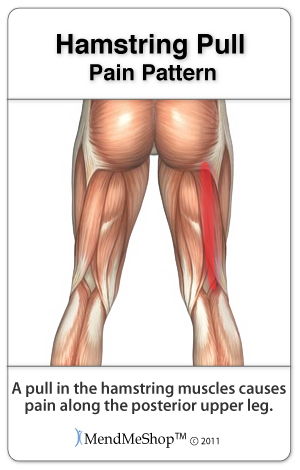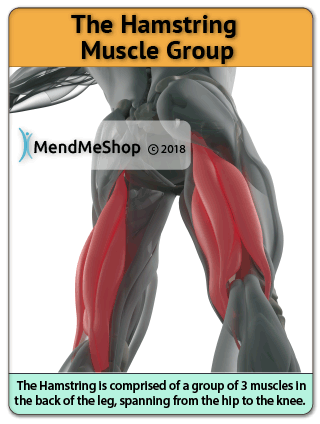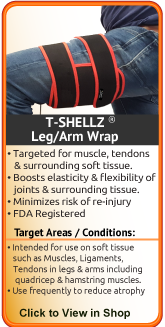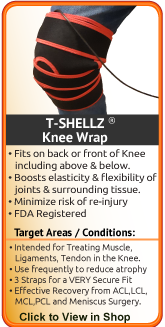 |
The posterior upper leg muscles provide your knees with mobility (extension, flexion and rotation) and strength. They work closely with your quadriceps muscles at the front of your thigh, your gluteal muscles, and your calf muscles to ensure proper movement of your leg and hip. The biceps femoris hamstring muscle is the most frequently injured, as it suffers the largest stretch during sprinting, followed by the semitendinosus muscle. If you have a multi-muscle injury, it normally occurs at the point where your hamstring muscles and tendons meet (musculotendinous junction) at the top of the hamstring muscles. However, hamstring pulls can also occur at any place along the hamstring muscle bellies or in the tendons that attach the muscles to the bones. A hamstring strain or hamstring sprain is soft tissue damage that causes pain and inflammation. These injuries can be caused by an acute injury in which the tissue is stretched or twisted beyond the limits or by a chronic injury that occurs with excessive use over time. The type of tissue that is damaged will determines whether the hamstring is sprained or strained. The difference between strain and sprain can be found on this page. Symptoms of a Pulled HamstringSymptoms are dependent on the severity of your hamstring injury. With a mild injury you may only notice tightness in the hamstring muscles, however, a more serious injury can cause weakness and severe pain in the posterior thigh. Common symptoms of hamstring pulls include: Hamstring PainA sharp pain or twinges may be felt along the length of your hamstring or at a specific point on the back of your thigh. You may experience tenderness and/or muscle spasms in your hamstring muscle during active and resistive movements. Pain often increases when pressure is applied to the injured hamstring muscles. It is possible to experience only mild pain when walking even if a tear in the muscle occurs, however, pain will increase if strenuous exercise is attempted. An avulsion, or complete tear causes extreme pain, even during rest. The torn tissue may bunch in the back of the thigh causing even more pain when the leg is bent.  If you have a chronic injury, you may feel more of a dull ache that lasts for long periods of time. Pain can be experienced while sitting or walking up or down stairs/hills. Decreased FlexibilityYou may experience stiffness or decreased range of motion (ROM) as a result of a pulled hamstring muscle. The tightness at the back of your thigh will make it difficult to flex your knee or straighten your leg. Your gait may be affected, or you may limp when you walk if the stiffness causes discomfort. Muscle spasm may also occur in the injured hamstring. Injury can make the muscle and/or nerves behave abnormally and improper contraction signals may be sent to the brain causing the muscle to spasm. Swelling and BruisingSwelling in your hamstring muscles is a result of your tissues becoming inflamed; this normally occurs with a more serious hamstring strain. Warmth and redness may accompany swelling in severe cases. You may also feel a gap, dent or bulge in your muscle that is not normally present. Occasionally, bruising (hamstring contusion) and discoloration over your hamstring muscle may appear immediately or after a few days with severe hamstring strains. Weakness Weakness or complete loss of function of your hamstring muscle can also be experienced as a result of a pulled hamstring. This along with your other symptoms may make it difficult for you to walk or run and can result in you walking with a limp. With an avulsion, or rupture, you will experience difficulties walking without assistance, a cane, or crutches. You could even feel a gap in your muscle with a complete tear. Popping NoiseA popping or snapping sensation at the back of your thigh can often be heard and felt when your hamstring muscles are tearing. This often happens with a large force of hip flexion when your knee is extended (straightened) and may cause you to fall to the ground. Hamstring Injury Treatments Hamstring injuries can be frustrating to live with and difficult to healing. The healing process takes time and you may find it difficult to give your leg the rest it needs. This is especially true for runners and other athletes that return to their sport too early. Re-injury is common but it prolongs recovery and may also lead to permanent damage and other conditions. Treating your hamstring injury correctly is essential to getting rid of your pain and restoring function to your hamstring muscles and tendons. Proper treatment will get you back to regular activities sooner, stop your pain, and reduce the risk of future re-injury. To restore strength and range of motion in your hamstrings, treatment should focus on preventing scar tissue formation and muscle atrophy (shrinkage and weakening of the muscle). This requires rest and the appropriate treatments at the right time. Almost all types of hamstring pulls and tears (except a complete hamstring rupture) can be properly treated with conservative treatment options available for use at home. Complete ruptures usually require surgery. However, using these home therapies after surgery can help speed recovery, improve function, and increase range of motion in your hamstrings. We have a whole website dedicated to the Hamstring at aidyourhamstring.com. More specific Hamstring information from this site is as follows:
Living with pain is never easy and we encourage you to call us with any questions you have related to your hamstring injury. We will do our best to help. Available Monday to FridayLearn More About Muscle Injuries & TreatmentsI want to learn more about Post-Surgery Recovery I want to learn more about muscle injury home treatment using the TShellz Wrap® I want to learn more about Ice & Heat: Which Is Better For Muscle Strains/Spasms? Do I Need Muscle Surgery?
|








